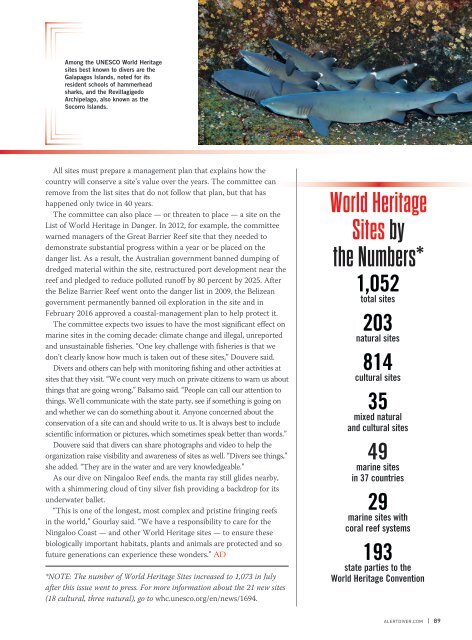AD 2017 Q3
Alert Diver is the dive industry’s leading publication. Featuring DAN’s core content of dive safety, research, education and medical information, each issue is a must-read reference, archived and shared by passionate scuba enthusiasts. In addition, Alert Diver showcases fascinating dive destinations and marine environmental topics through images from the world’s greatest underwater photographers and stories from the most experienced and eloquent dive journalists in the business.
Alert Diver is the dive industry’s leading publication. Featuring DAN’s core content of dive safety, research, education and medical information, each issue is a must-read reference, archived and shared by passionate scuba enthusiasts. In addition, Alert Diver showcases fascinating dive destinations and marine environmental topics through images from the world’s greatest underwater photographers and stories from the most experienced and eloquent dive journalists in the business.
Create successful ePaper yourself
Turn your PDF publications into a flip-book with our unique Google optimized e-Paper software.
Among the UNESCO World Heritage<br />
sites best known to divers are the<br />
Galapagos Islands, noted for its<br />
resident schools of hammerhead<br />
sharks, and the Revillagigedo<br />
Archipelago, also known as the<br />
Socorro Islands.<br />
STEPHEN FRINK<br />
All sites must prepare a management plan that explains how the<br />
country will conserve a site’s value over the years. The committee can<br />
remove from the list sites that do not follow that plan, but that has<br />
happened only twice in 40 years.<br />
The committee can also place — or threaten to place — a site on the<br />
List of World Heritage in Danger. In 2012, for example, the committee<br />
warned managers of the Great Barrier Reef site that they needed to<br />
demonstrate substantial progress within a year or be placed on the<br />
danger list. As a result, the Australian government banned dumping of<br />
dredged material within the site, restructured port development near the<br />
reef and pledged to reduce polluted runoff by 80 percent by 2025. After<br />
the Belize Barrier Reef went onto the danger list in 2009, the Belizean<br />
government permanently banned oil exploration in the site and in<br />
February 2016 approved a coastal-management plan to help protect it.<br />
The committee expects two issues to have the most significant effect on<br />
marine sites in the coming decade: climate change and illegal, unreported<br />
and unsustainable fisheries. “One key challenge with fisheries is that we<br />
don’t clearly know how much is taken out of these sites,” Douvere said.<br />
Divers and others can help with monitoring fishing and other activities at<br />
sites that they visit. “We count very much on private citizens to warn us about<br />
things that are going wrong,” Balsamo said. “People can call our attention to<br />
things. We’ll communicate with the state party, see if something is going on<br />
and whether we can do something about it. Anyone concerned about the<br />
conservation of a site can and should write to us. It is always best to include<br />
scientific information or pictures, which sometimes speak better than words.”<br />
Douvere said that divers can share photographs and video to help the<br />
organization raise visibility and awareness of sites as well. “Divers see things,”<br />
she added. “They are in the water and are very knowledgeable.”<br />
As our dive on Ningaloo Reef ends, the manta ray still glides nearby,<br />
with a shimmering cloud of tiny silver fish providing a backdrop for its<br />
underwater ballet.<br />
“This is one of the longest, most complex and pristine fringing reefs<br />
in the world,” Gourlay said. “We have a responsibility to care for the<br />
Ningaloo Coast — and other World Heritage sites — to ensure these<br />
biologically important habitats, plants and animals are protected and so<br />
future generations can experience these wonders.” <strong>AD</strong><br />
*NOTE: The number of World Heritage Sites increased to 1,073 in July<br />
after this issue went to press. For more information about the 21 new sites<br />
(18 cultural, three natural), go to whc.unesco.org/en/news/1694.<br />
World Heritage<br />
Sites by<br />
the Numbers*<br />
1,052<br />
total sites<br />
203<br />
natural sites<br />
814<br />
cultural sites<br />
35<br />
mixed natural<br />
and cultural sites<br />
49<br />
marine sites<br />
in 37 countries<br />
29<br />
marine sites with<br />
coral reef systems<br />
193<br />
state parties to the<br />
World Heritage Convention<br />
ALERTDIVER.COM | 89









